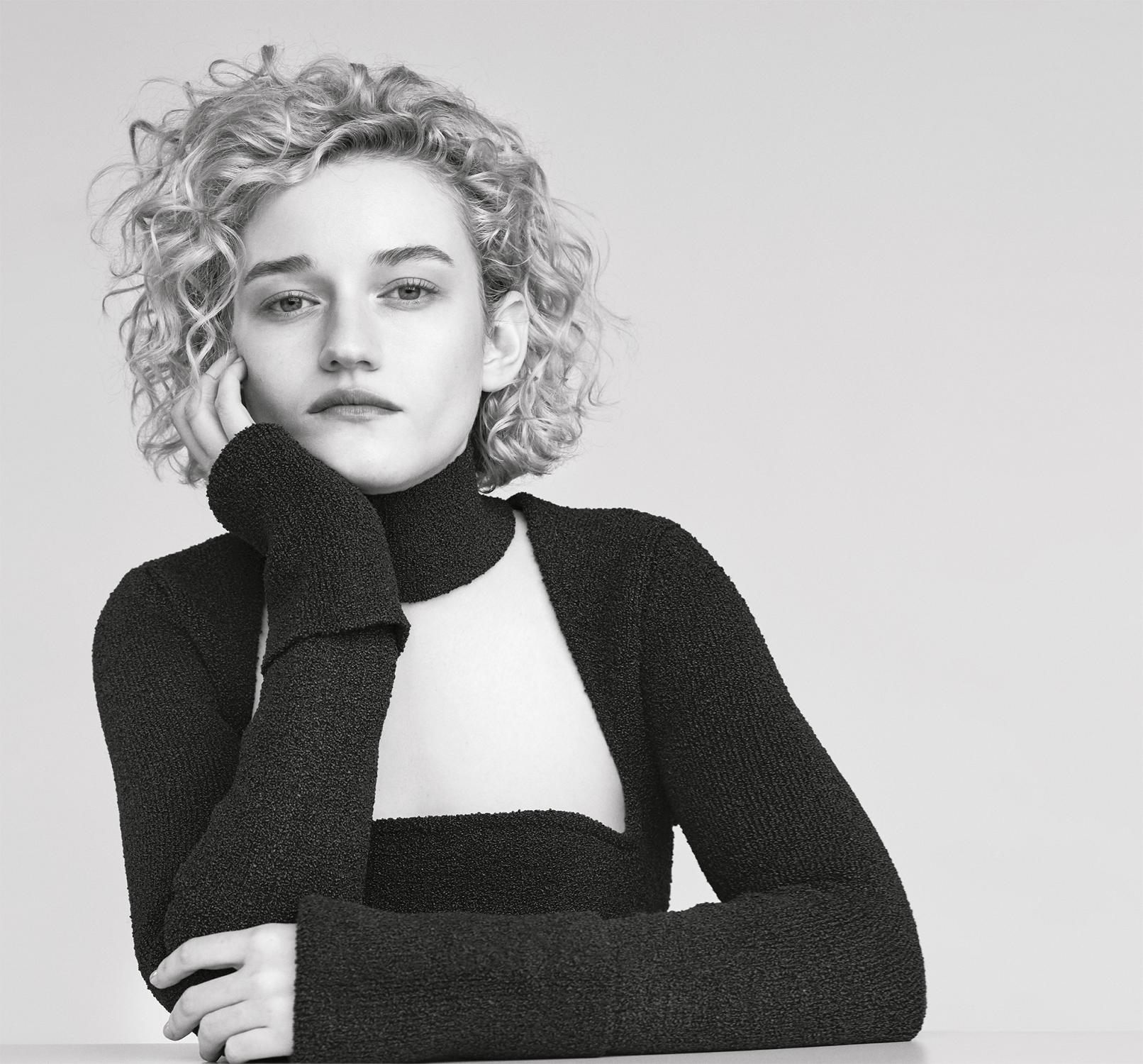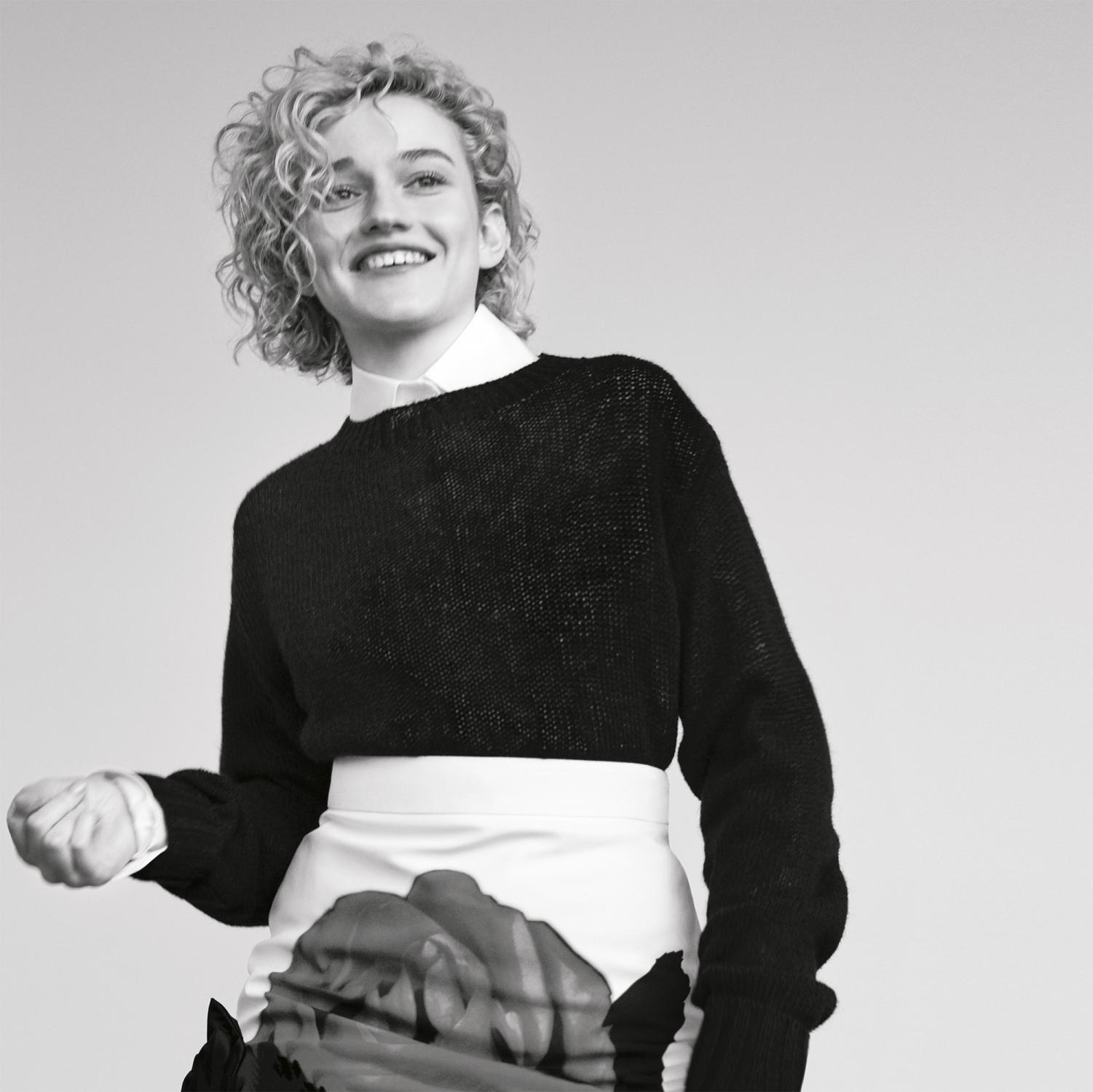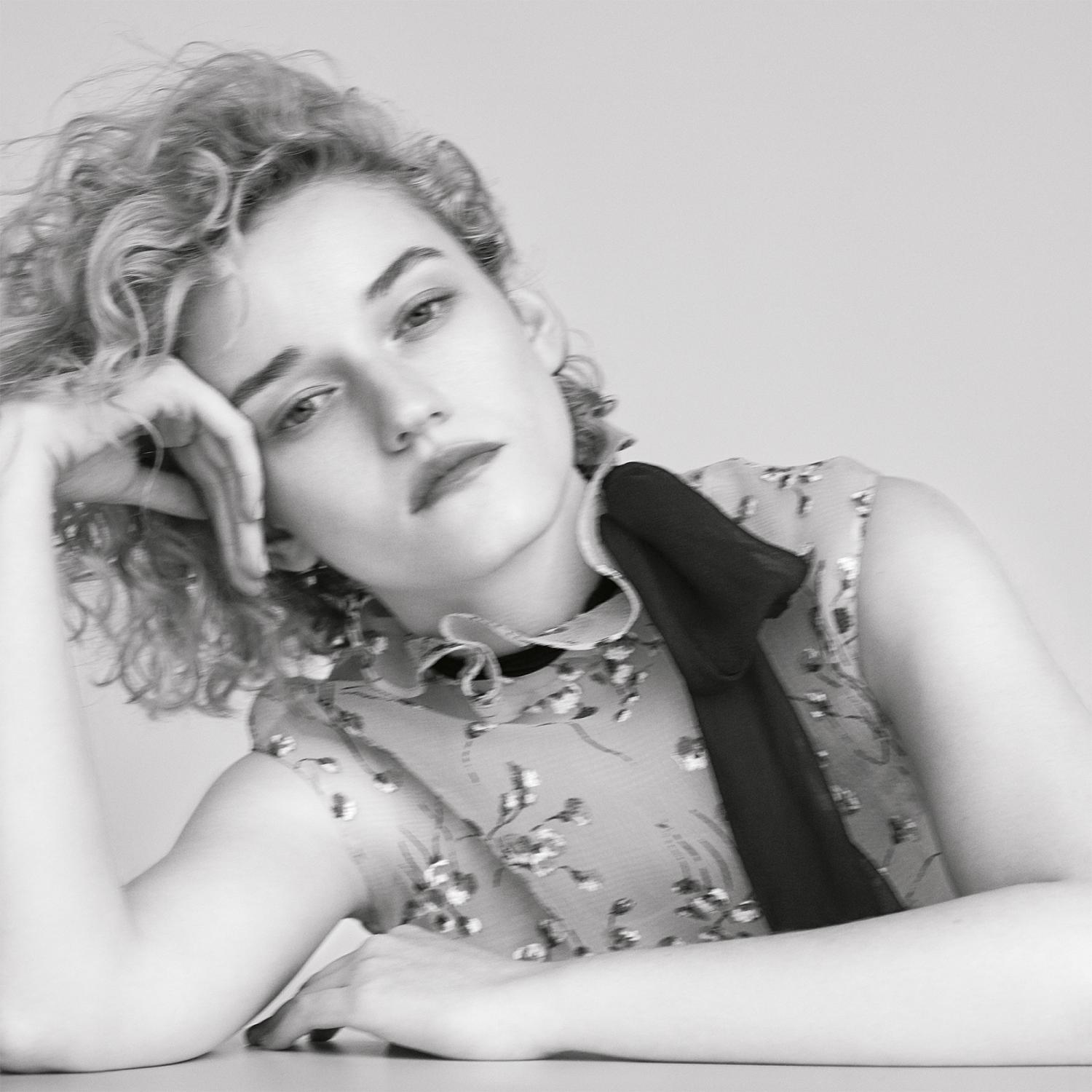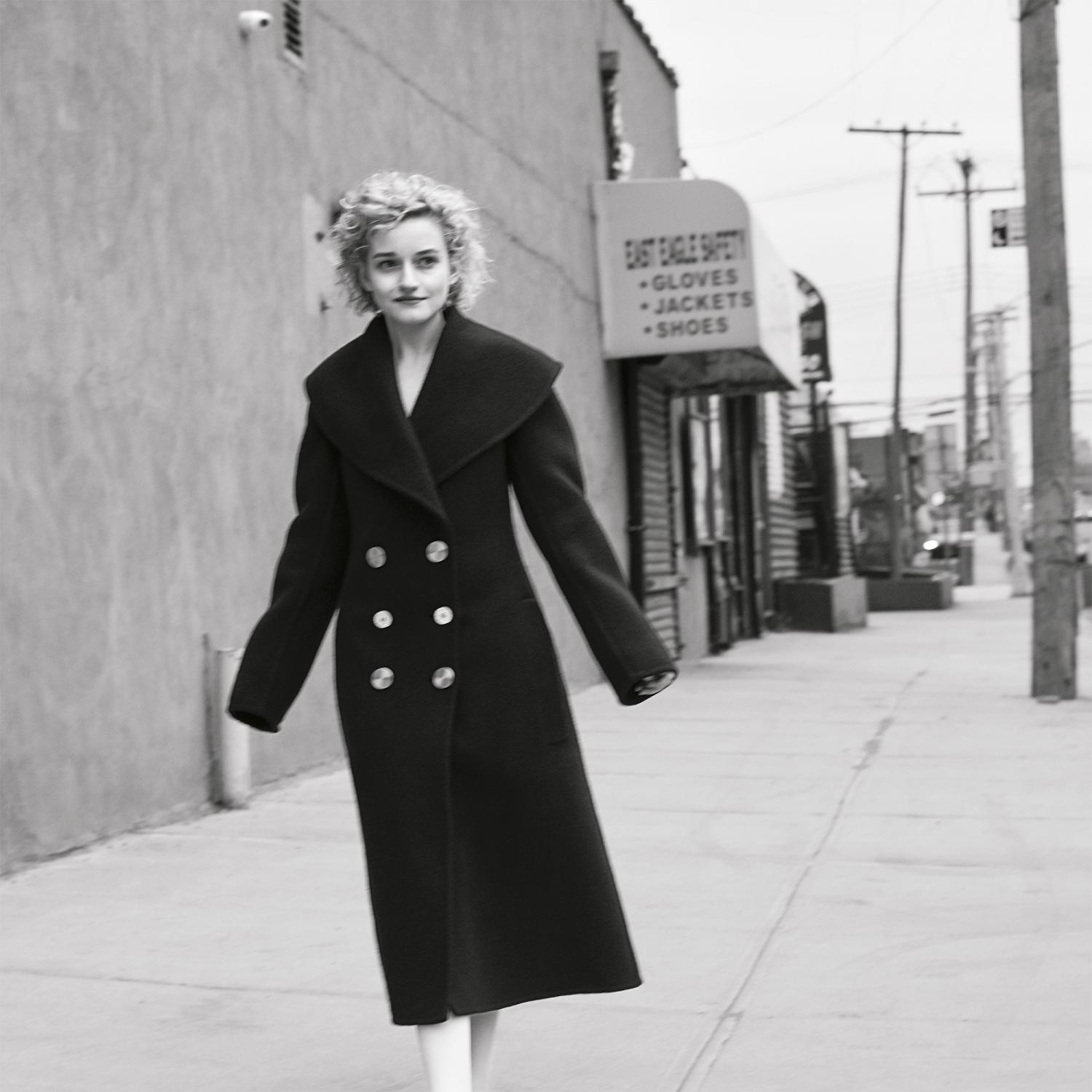Julia
Garner
Redefining the antiheroine.

Portraits by Bruno Staub
Styling by Alex Harrington
Issue nº 20, Autumn & Winter 2019
With her gangster’s-moll looks, creaky little voice and knack for losing herself in a part, Julia Garner is the actor with the power that makes Lily Tomlin, Jason Bateman and Laura Linney sit up and say, “Well, hello.” One of a new breed of actors who are tapping the deep dramatic well opened up by streaming media, Julia, 25, is racking up awards for her gutsy portrayals of young women on the edge. And if her electrifying turn in Netflix’s Ozark is anything to go by, Julia has plenty more to tell us about unconventional girls.
As a child growing up in Riverdale, New York, Julia Garner, the second daughter of creative, cultured parents, watched a lot of classic movies. “I used to watch with my parents, who were big movie fans,” says Julia, who is 25 and has starred in a spate of indie films but is best known for her ingenious turn as Ruth Langmore, the teenage matriarch of a family of petty criminals in Ozark, Netflix’s hit drama. Julia watched – and loved – All About Eve when she was just nine years old. And Rosemary’s Baby when she was 11. “And then when I was 12,” she says, “Netflix started with the DVDs that they would send to you, and I remember watching Taxi Driver for the first time on my laptop in bed.”
With her almond-shaped navy-blue eyes, dimples, and blond curls that frame her face like a golden aura, Julia might have emerged from a classic movie herself. She’s some hard-to-pinpoint mix of Jean Harlow, Marlene Dietrich and Marilyn Monroe, and like all of those women, she has a look that is distinctly her own. “She’s unique,” says Lily Tomlin, Julia’s co-star in the independent film Grandma. “She doesn’t look like anyone else.” Julia also doesn’t look like other twenty-something actresses. At five feet four, she has a delicate frame but is not muscular. Her lips are thin (so rare, so retro) and usually emphasised by lipstick in man-eating red. There’s a gap between her two front teeth. She is as pale as powder. Kitty Green, the director of the forthcoming The Assistant, in which Julia stars as an employee of Harvey Weinstein, says, “When we were casting, we were looking for a lead who was not only an extraordinary talent but who also had a unique look that could cut through the drab fluorescent office lighting.”
We meet on a rainy late-June day at Ponce City Market, an open-air shopping mall in Atlanta, Georgia, where Julia is filming the third season of Ozark, a gritty and cerebral show about family, socio-economic class and the Midwest. She is wearing a white linen button-down blouse, denim shorts and wedge sandals. On her ring finger is a four-carat diamond set atop a band of tiny ones. In April, during a 10-day RV trip across the American West, her boyfriend, Mark Foster, the 35-year-old lead singer of the indie pop band Foster the People, asked her to marry him. “He proposed to me in Yellowstone,” she says. She stretches out her hand, her fingers long and slender as a pianist’s.
Today is one of Julia’s rare days off. But instead of doing her laundry, taking a barre class (her preferred form of exercise – “I hate the feeling of working out, the hyperventilating, the sweating”), or simply resting, she is here, at an Italian restaurant, eating gluten-free pasta bolognese and burrata salad.
Julia believes that her looks led, at least in part, to her career of unconventional roles. “Early on, I saw that I wasn’t getting cast as the girl next door, I wasn’t getting cast as the ‘daughter of’,” she says. Her first role, in 2011, was as a cult initiate in the celebrated indie film Martha Marcy May Marlene. She went on to play a pregnant Mormon teen who leaves a repressive religious colony because she thinks a song on a tape recorder impregnated her (Electrick Children, 2012), a cannibal (We Are What We Are, 2013, an English-language remake of a Mexican horror movie), another pregnant teen who asks her lesbian poet grandmother for $630 for an abortion (Grandma, 2015), and an idealistic trailer-park drifter with curls the colour of ketchup (Tomato Red, 2017).

A regular at the ballet barre, Julia puts the moves on a black, red and pink rose-print skirt by PRADA. Tucked in is a black wool crew-neck jumper over a white cotton shirt, also by PRADA. In the opening image, she is in an oxblood knitted-silk dress by BOTTEGA VENETA.
Julia’s career seemed poised to follow the same trajectory as that of an indie queen like Parker Posey, Christina Ricci or Chloë Sevigny (like the latter, she is a fashion-world favourite and has appeared in ads for Miu Miu and Kate Spade and walked for Balenciaga at Paris fashion week). But in the past two years, following the acclaim for her portrayal of Ruth Langmore – a character who is fiery, cunning and barbed-wire-sharp but also a vulnerable young girl – Julia’s career has begun to take on a much more contemporary cast. It is often said that we are in the golden age of television, but it is also the heyday of the limited series, which allows actors to appear in a show without having to commit to multiple seasons.
Julia is the breakout star of Ozark, earning nominations for a Critics’ Choice Award, two Screen Actors Guild Awards and, recently, a best-supporting-actress Emmy (the winner will be announced in mid-September). As her renown has increased, so, too, has the number of television projects she’s involved in. In the past year, she has played the sister of David Koresh’s wife, Rachel, in Paramount Network’s Waco, a six-part chronicle of the deadly 51-day stand-off between the FBI, the Bureau of Alcohol, Tobacco and Firearms and the Branch Davidians. She was Emma Stone’s sweet-natured younger sister, Ellie, in the surreal, genre-bending Maniac, a Netflix series about strangers thrown together during an experimental drug trial. And in Dirty John (filmed during 80 days of Ozark’s off-season), she played the gentle, perspicacious younger daughter who sees right through her mother’s (played by Connie Britton) con-man suitor (Eric Bana). Julia’s pitch-perfect portrayal of Terra, with her nasal Californian accent and millennial upspeak, earned her a Critics’ Choice nomination – she might have been the “daughter of”, but she was also the quirky, zombie-obsessed character on whom the series’ violent, dramatic climax hinged. “She was the dragon slayer,” Dirty John’s director, Jeff Reiner, tells me. Julia says, “There had to be a twist.”
Julia’s filming schedule for Ozark can involve 16-, 17-, 18-hour days, and playing a character as intense, combative and vituperative as Ruth is challenging. The show centres on a Chicago financial planner, Marty, played by Jason Bateman, who moves his family to the Ozark Mountains to launder money for a Mexican drug cartel after a similar scheme in Chicago goes wrong. There, he comes up against local criminals the Langmores. Julia’s role as the foul-mouthed 19-year-old is physical, requiring her to drive a speedboat, handle a shotgun, and get in people’s faces and yell. But Ruth’s storyline is emotionally heavy as well. She is abused by her father (in one scene, he throws her against the dashboard of his truck), electrocutes her duplicitous uncles, gets waterboarded by the cartel and is deeply anguished about her growing loyalty to Marty, who becomes a kind of surrogate father to her. “When I was first playing Ruth, it was really tough,” she says. “It almost felt like I had been hit with a frying pan every single night.”
Julia tries to “decompress”, as she puts it, from making television by watching television – she likes The Real Housewives of Beverly Hills and Bodyguard. She also spends time with her co-stars. Marooned as they are for six months a year in Atlanta, they have formed a de facto family. Indeed, the actors who play the Langmores have a text group called “Langmore familia”. “We’re all really close,” Julia says. Charlie Tahan, who plays Ruth’s cousin Wyatt, and Sofia Hublitz, who plays Marty’s teenage daughter, Charlotte, live in the same building as Julia. Trevor Long, who plays Ruth’s father, Cade, tells me they often watch television together. “Julia got me hooked on Curb Your Enthusiasm,” he says. “She had me come over to her apartment with Charlie and we watched three or four seasons – we were like a dysfunctional family off set, but in a very fun way.”

“When I was 12, Netflix started with the DVDs they would send you, and I remember watching Taxi Driver on my laptop in bed.”
Family, biological and chosen, is a conversational theme for Julia. She talks about her own with warmth and admiration. Her childhood was, she says, “like a Noah Baumbach film”, which paints a picture at once evocative and specific. Her mother, Tamar Gingold, is Jewish, a comedic actress who appeared on the Israeli equivalent of Saturday Night Live and became a therapist when she moved to America in her 20s. Her father, Thomas, an artist who also teaches at junior school, is “a WASP” from Shaker Heights, Ohio. “But, like, he’s Jewish,” Julia jokes. Julia’s sister, Anna, is three years older and teaches special education and English as a second language in a Manhattan high school. Julia describes “a full-on New York Jewish household” with “books and rugs and the philosophy and the paintings… just cactuses and books and, like, old electronics and a Matisse poster in the silver frame from the Metropolitan Museum.”
She calls her parents “very academic”, but she was not a fan of school herself. “I was the worst student. I hated school. I hated it,” she says. “It was definitely a challenge for me. I would never get in trouble or anything; teachers really liked me, but it was very hard.” She struggled with a severe learning disability that made it difficult for her to read. “I couldn’t put the words together,” she explains. “There was one point where they thought I was legally letter-blind.” As a result, her future seemed uncertain. “If you can’t read, there’s not a lot you can do. Reading is everything. It was like, ‘What’s Julia going to do?’”
But Julia did eventually learn to read. “The brain, it’s muscle. It’s like going to the gym and exercising – eventually you’re going to get it.” But reading is still not easy for her, and she doesn’t take it for granted. “The best way to put it is, it’s very surprising that I’m doing this profession because so much of it is language,” she says. “Sometimes, when I am being extremely hard on myself, I have to step back and remember the place that I was in, that I couldn’t read.”
Paradoxically, those insecurities were what set her on her current path. “I started acting because I had such confidence issues, because I wasn’t literate and couldn’t articulate myself in the way I wanted to,” she says. “Almost everything that I said, I felt it was just dumb in a way.” She took her first acting class (at T. Schreiber Studio in New York) when she was 14, and loved it. “My mom was a little worried because of my problem, but I was like, ‘No, I really want to do it.’”
Soon she was auditioning for student films, mostly shorts, at Columbia’s film school. As she was still a minor, her sister would take her. Julia taught herself to memorise lines. “I do the scene over and over,” she says. One of the student filmmakers had a girlfriend, Susan Shopmaker, who was interning at a casting office. (She would go on to cast numerous independent movies, including Party Monster and Goat.) At the time, she was helping to cast the American remake of the British teen drama Skins. In late 2010, an open call was advertised on Facebook, so Julia went; 1,500 other kids were there to audition. The crowd was reduced to 30 hopefuls, who were put in a room, divided into groups, and told to improvise. “It finally came down to me and another girl out of the 1,500 kids,” Julia remembers. “That was my first professional audition.” She didn’t get that role, but five months later, when Shopmaker was casting Martha Marcy May Marlene, she gave Julia her first part.
“The thing I liked most about acting,” Julia says, “is that I was saying someone else’s words, but it was my emotions. I could just say it through someone else.” Acting gave her language, a means of communication. She also liked the feeling of forgetting herself. “I remember the first time being so lost in the moment that when they said, ‘OK, cut!’ I didn’t remember what I’d done. I like that weird out-of-body experience.” Now, if she does remember a scene, she’ll ask to reshoot it. “There’s something about her ability to tap in,” Chris Mundy, Ozark’s executive producer, says. “I never feel like I’m watching gears turn.”

Right up our street: Julia is wearing an oversized black wool coat with gold buttons by LOEWE with white tights from BLOCH. In the previous image, Julia is wearing a pale-blue embroidered chiffon sleeveless dress over a pale-pink cotton tank top, both by MIU MIU.
It is curious to witness someone on the brink of real celebrity, the kind of fame where they get asked for autographs (or, nowadays, selfies) and can’t eat at a restaurant without being interrupted multiple times. This sort of energy is palpable, and it trails Julia. In its first two seasons, Ozark has become a sleeper hit. Although Netflix keeps its viewing numbers under wraps, the data analysis firm Parrot Analytics ranked Ozark as the most streamed show during the summer of 2017, with 16.7 million viewers, and last autumn, Nielsen ranked it at number 10, with 13.9 million.
What this means for Julia is that she now gets recognised. A lot. People have begun asking to take pictures with her, which she doesn’t mind. “The only time it’s a little strange is when they don’t come up to you and they don’t say anything. Their phone is just up for 30 seconds too long.” When I ask her how the attention has affected her life, she says, “That’s something you work for as an actor. If you see an actor and they say, ‘I didn’t ask for this,’ it’s like, ‘Yes, you did.’ Come on.” Unlike most young actors, Julia is only minimally on social media (she has an Instagram account but posts infrequently), and this may be the most Old-Hollywood-movie-star thing about her. “Actresses have to manage a whole other landscape now,” says Laura Linney, who plays Marty’s smart, crafty wife, Wendy, in Ozark. “What can happen is that the marketing end of it can eclipse the talent, and make that not the primary focus, and I think she’s doing a really nice job of balancing that.”
Ozark’s Ruth is on her way to becoming as memorable a character as Karen Walker, Liz Lemon or Betty Draper, and it’s not surprising she’s caught on. Her determined ferocity as she rises from hotel maid who steals her boss’s money to trusted business associate in charge of his strip club and privy to his secrets is riveting to watch. She’s canny and street-smart (“I don’t read books, I read texts,” Ruth says), with a scheme and a swear word for every situation, delivered in a syrupy Missouri twang. (Julia nearly decided against the Ozarks accent, which she’d done in Tomato Red, when she heard the other actresses at the audition saying their lines straight, but she’d only practised with the accent and couldn’t recall her lines without it.) Linney, who has been taken with Julia since the start of the first season, says, “The minute she cocked her head and a piece of hair sort of juggled in the wind and that voice came out, you were like, Oh, wow. Well, hello. It’s delightful.” For his part, Jason Bateman has said, “As soon as Julia started, we were like, Oh, this is going to be a much bigger character than even in the [show] bible.”
A trailer-park-dwelling teenage criminal mastermind could have been an implausibly cartoonish figure, but Julia renders her believable. The key to Ruth, and to all the characters Julia plays, is that she imbues them with layers of humanity and emotion. We glimpse Ruth’s fragility when we see her ever so slightly flinch as she watches Wendy hug her daughter, Charlotte; and again as she sits in the back of Wendy’s car, tiny in her denim skirt and lace top, crying after seeing her father in jail. “I softened her,” Julia says. “Maybe she’s not a sociopath. Maybe she’s just a girl who was born in the wrong place and doesn’t know how to behave.” Kitty Green, the director of The Assistant, says Julia “has the emotional understanding of someone much older. She’s sensitive and curious, and she has a beautifully intimate understanding of her character’s inner world.”
To get to this point, Julia puts in plenty of preparation. For one, she keeps a diary. “I write in a journal almost the same way that anybody would write in a journal, except I write as the character,” she says. “I’ll be, like, ‘Dear Diary, today I was really upset at Marty because he didn’t give me 10 grand.’ Or whatever.” She also gets a character’s accent right. “She’s a very good mimic,” Trevor Long says. Julia adds, “It’s like going to work with a wig and then going home with no wig. You’re like, Oh, this is not me.” And then she has a precise sense of detail – she was the one who suggested that Ruth wear the winsome cat watch. “There’s just something about a cute watch that makes it more creepy,” she says. “Like, she’s still a girl, but she’s crazy and might cut your throat.”
Amanda FortiniAmanda Fortini has written for The New York Times, the New Yorker, Rolling Stone, the Paris Review and New York magazine, among other publications. She has worked as an editor at Mirabella, The New York Review of Books and Slate, and has been the William Kittredge Visiting Professor at the University…read more Portraits by
Bruno StaubRenowned for his stylish, close-up portraiture, the French fashion photographer Bruno Staub swapped his hometown of Paris for New York, where he now lives and works in Brooklyn, to be specific. His images have been published in magazines including Fantastic Man, Butt and Man About Town, and commissioned…read more Styling by
Alex HarringtonAlex Harrington is a New York-based stylist. An art history major, Alex got his start in fashion in 2010 as an assistant to the stylist Camilla Nickerson before making the break to go it alone in 2015. Since then, Alex has built an impressive portfolio out of his regular contributions to publications…read more
Hair: Bobby Eliot at Starworks Artists. Make-up: Dick Page at Statement Artists. Photographic assistance: Evan Browning. Styling assistance: Luca Galasso. Production: Total Management.
This profile was originally published in The Gentlewoman nº 20, Autumn & Winter 2019.